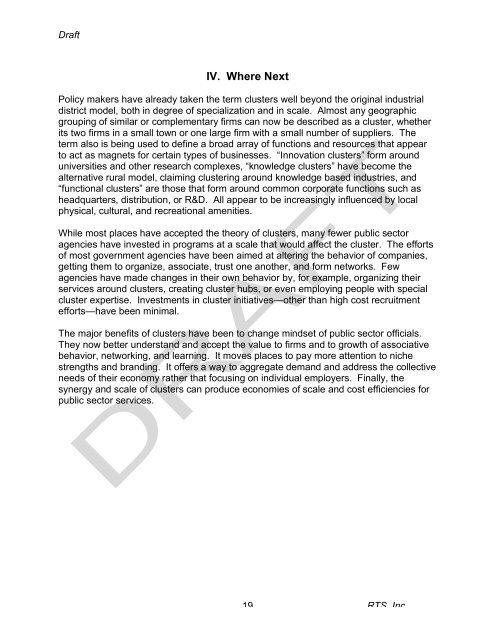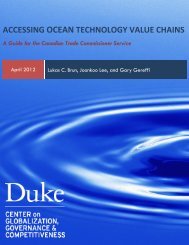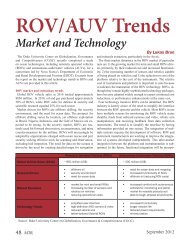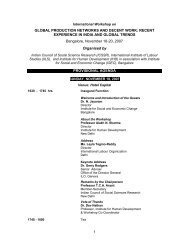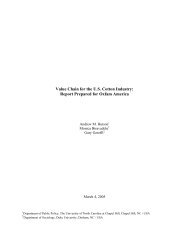Paper - Center on Globalization, Governance & Competitiveness
Paper - Center on Globalization, Governance & Competitiveness
Paper - Center on Globalization, Governance & Competitiveness
You also want an ePaper? Increase the reach of your titles
YUMPU automatically turns print PDFs into web optimized ePapers that Google loves.
Draft<br />
IV. Where Next<br />
Policy makers have already taken the term clusters well bey<strong>on</strong>d the original industrial<br />
district model, both in degree of specializati<strong>on</strong> and in scale. Almost any geographic<br />
grouping of similar or complementary firms can now be described as a cluster, whether<br />
its two firms in a small town or <strong>on</strong>e large firm with a small number of suppliers. The<br />
term also is being used to define a broad array of functi<strong>on</strong>s and resources that appear<br />
to act as magnets for certain types of businesses. “Innovati<strong>on</strong> clusters” form around<br />
universities and other research complexes, “knowledge clusters” have become the<br />
alternative rural model, claiming clustering around knowledge based industries, and<br />
“functi<strong>on</strong>al clusters” are those that form around comm<strong>on</strong> corporate functi<strong>on</strong>s such as<br />
headquarters, distributi<strong>on</strong>, or R&D. All appear to be increasingly influenced by local<br />
physical, cultural, and recreati<strong>on</strong>al amenities.<br />
While most places have accepted the theory of clusters, many fewer public sector<br />
agencies have invested in programs at a scale that would affect the cluster. The efforts<br />
of most government agencies have been aimed at altering the behavior of companies,<br />
getting them to organize, associate, trust <strong>on</strong>e another, and form networks. Few<br />
agencies have made changes in their own behavior by, for example, organizing their<br />
services around clusters, creating cluster hubs, or even employing people with special<br />
cluster expertise. Investments in cluster initiatives—other than high cost recruitment<br />
efforts—have been minimal.<br />
The major benefits of clusters have been to change mindset of public sector officials.<br />
They now better understand and accept the value to firms and to growth of associative<br />
behavior, networking, and learning. It moves places to pay more attenti<strong>on</strong> to niche<br />
strengths and branding. It offers a way to aggregate demand and address the collective<br />
needs of their ec<strong>on</strong>omy rather that focusing <strong>on</strong> individual employers. Finally, the<br />
synergy and scale of clusters can produce ec<strong>on</strong>omies of scale and cost efficiencies for<br />
public sector services.<br />
19<br />
RTS, Inc.


